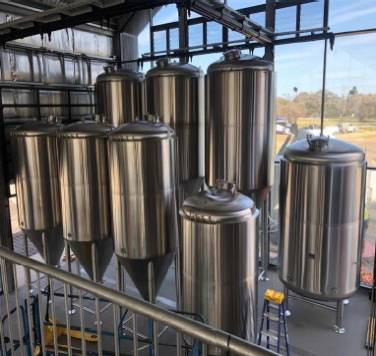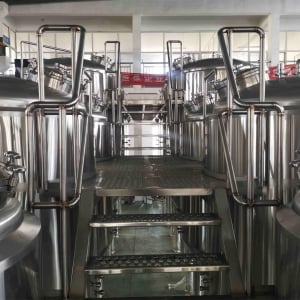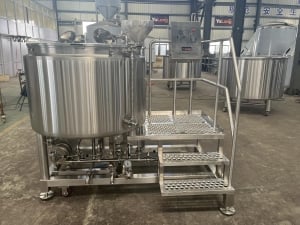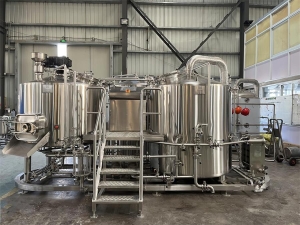Table of Contents
ToggleIntroduction
If you’re a beer enthusiast with dreams of turning your passion into a business venture, understanding the ins and outs of a commercial brewing system is crucial. This article dives deep into the world of commercial brewing systems, exploring their components, types, setup, maintenance, and the benefits they offer. Whether you’re considering opening a microbrewery, a craft brewery, or an industrial-scale operation, this guide will provide valuable insights to help you make informed decisions.
Understanding Commercial Brewing Systems
A commercial brewing system is a meticulously designed setup that allows breweries to produce beer on a larger scale compared to home brewing. It involves various components working harmoniously to transform raw ingredients into the beloved beverage we all enjoy. Let’s take a closer look at the key elements that make up a commercial brewing system.
Components of a Commercial Brewing System
Commercial brewing systems consist of several essential components that contribute to the brewing process. These include brewing kettles and mash tuns, fermentation tanks, and boilers and chillers.
Brewing Kettles and Mash Tuns
Brewing kettles and mash tuns are where the magic begins. The brewing kettle is where malt, hops, and water are combined and boiled to create the wort, the liquid that eventually becomes beer. Mash tuns, on the other hand, are used to steep the malt and convert its starches into fermentable sugars.
Fermentation Tanks
After the wort is prepared, it’s transferred to fermentation tanks. Here, yeast is added, and the fermentation process begins. The yeast converts the sugars in the wort into alcohol and carbon dioxide, resulting in the creation of beer.
Boilers and Chillers
Boilers and chillers play a crucial role in regulating temperatures throughout the brewing process. Boilers are used to heat water for mashing and boiling, while chillers help cool the wort before fermentation and maintain proper fermentation temperatures.

Types of Commercial Brewing Systems
Commercial brewing systems come in various sizes and configurations to accommodate different levels of production. The three main types of commercial brewing systems are microbrewery systems, craft brewery systems, and industrial brewery systems.
Microbrewery Systems
Microbrewery systems are ideal for small-scale production, often focusing on unique and experimental brews. They allow for greater creativity and flexibility in recipe development. Microbreweries are known for their close connection to their local communities and their emphasis on quality over quantity.
Craft Brewery Systems
Craft brewery systems strike a balance between microbreweries and large-scale industrial operations. They produce larger quantities of beer than microbreweries while maintaining a strong commitment to quality and creativity. Craft breweries often distribute their products to local bars, restaurants, and stores.
Industrial Brewery Systems
Industrial brewery systems are designed for large-scale production and distribution. These systems are capable of producing vast quantities of beer to meet high demand. While efficiency and consistency are crucial, some industrial breweries still prioritize craft-style brewing techniques to maintain the integrity of their products.
Factors to Consider When Choosing a Commercial Brewing System
Selecting the right commercial brewing system requires careful consideration of several factors.
Batch Size and Production Capacity
Your intended batch size and production capacity will influence the type of brewing system you choose. Microbreweries can start with smaller systems, while larger operations may require industrial setups.
Space and Layout
The available space in your brewing facility will dictate the size and layout of your brewing system. Efficient use of space is essential for workflow optimization and safety.
Efficiency and Automation
Modern brewing systems often come with automation features that help control various aspects of the brewing process. Automation can enhance efficiency, consistency, and data collection.

Setting Up a Commercial Brewing System
Setting up a commercial brewing system involves multiple steps to ensure a smooth and successful operation.
Location and Permits
Choosing a suitable location and obtaining the necessary permits and licenses are critical steps. Zoning regulations, environmental permits, and health department approvals must be secured.
Installation and Setup
Professional installation of brewing equipment is essential to ensure proper functionality and safety. Collaborate with experts to set up the brewing system correctly.
Quality Control Measures
Implementing quality control measures, such as regular testing and sensory evaluations, ensures that the beer consistently meets your desired standards.
Maintenance and Cleaning of Brewing Equipment
Regular maintenance and cleaning are vital to the longevity and performance of your brewing equipment.
Regular Inspections and Maintenance
Schedule routine inspections to identify and address any equipment issues promptly. Preventive maintenance reduces the risk of unexpected breakdowns.
Cleaning Procedures and Sanitization
Maintain strict cleaning and sanitization protocols to prevent contamination and ensure the quality and safety of your beer.
Benefits of a Well-Designed Commercial Brewing System
Investing in a well-designed commercial brewing system offers a range of benefits that can positively impact your brewing business.
Consistency in Quality
A well-calibrated brewing system ensures that each batch of beer maintains consistent flavor, aroma, and quality. This reliability builds customer loyalty and trust.
Increased Production Efficiency
Efficient brewing processes, automation, and optimized layouts lead to higher production efficiency. This means more beer can be produced in less time, allowing you to meet demand and grow your business.
Room for Creativity and Experimentation
Even in larger setups, a well-designed brewing system can still allow for creative experimentation. You can continue crafting unique and innovative brews that set your brand apart.
Challenges in Operating a Commercial Brewery
Operating a commercial brewery comes with its share of challenges that you must navigate to achieve success.
Cost Considerations
Starting and running a brewery involves significant upfront costs for equipment, ingredients, permits, and facilities. Managing expenses and budgeting effectively are essential.
Regulatory Compliance
Brewing is regulated by various local, state, and federal authorities. Adhering to licensing, labeling, health, and safety regulations is crucial to avoid legal issues.
Competition and Marketing
The brewing industry is competitive, with many players vying for consumer attention. Effective marketing strategies, branding, and distribution are vital for standing out.
The Future of Commercial Brewing Systems
As technology continues to advance, the future of commercial brewing systems holds exciting possibilities.
Incorporation of AI and Data Analytics
Automation and data-driven insights will play a more significant role in optimizing brewing processes and quality control.
Sustainable Practices
Environmental consciousness will drive breweries to adopt more sustainable practices, such as energy-efficient brewing methods and eco-friendly packaging.
Conclusion
Operating a commercial brewing system requires a blend of artistry, science, and business acumen. Whether you’re crafting small-batch artisanal beers or producing large quantities for the masses, a well-designed brewing system is the backbone of your operation. By considering factors such as batch size, efficiency, and quality control, you can create a successful and thriving brewery that delivers exceptional beers to your customers.
FAQs
1. How much space do I need for a commercial brewing system? For a microbrewery, you might need around 1,000 to 3,000 square feet, while larger setups could require 5,000 square feet or more.
2. What permits do I need to open a brewery? Permits vary by location, but typically, you’ll need federal and state permits, along with local licenses for zoning and health regulations.
3. Can I start a brewery with no brewing experience? While brewing experience is beneficial, you can collaborate with experienced brewers or take brewing courses to learn the craft.
4. How long does it take to set up a commercial brewing system? The setup timeline varies based on factors like equipment availability and permits. It can take several months to a year.
5. Is automation necessary for a brewing system? Automation can enhance efficiency and consistency, but it’s not mandatory. Many successful breweries operate with varying levels of automation.










